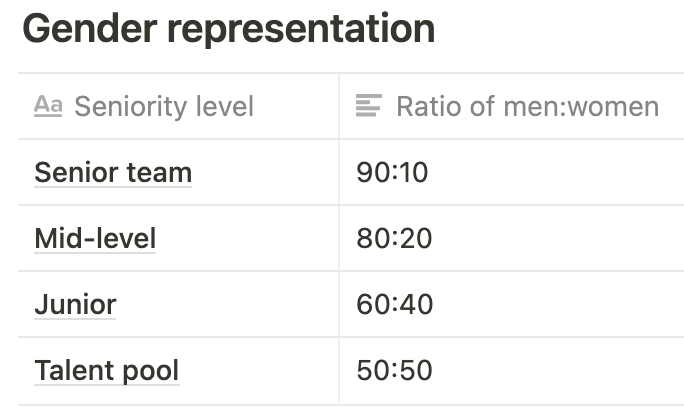GPA diversity goals: A framework for improving diversity in the workplace

In this post, we introduce the Gender Proportionality Aspiration (GPA) model for setting diversity goals. This framework encourages gradual change towards ideal diversity levels, involving every level of your workplace at once. If you’re looking to make meaningful change from bottom to top, this framework is a powerful way to get there.
Our previous post introduced you to how to set SMART goals for diversity that set your sights high. If you’re looking for a more structured and data-driven approach to diversity goals, this is the post for you.
The Gender Proportionality Aspiration framework (GPA) is a goal-setting model that encourages gradual change towards ideal diversity levels.
Through a double-pronged approach of hiring diversely and promoting underrepresented talent, you can achieve a fair representation of all groups at every level of your organisation.

Checklist of actions:
- Decide which metrics of diversity you want to improve
- Calculate the ratio of representation at every level of your company
- Set your goals in 2-year cycles using the GPA framework — input comes from the level below!
How does it work?
The GPA framework uses the makeup of your company as input for goals. The ratio of demographic groups at any level in your company should mirror one seniority level lower, with the general talent pool being level zero.
In 2 year cycles, you work towards achieving the representation of the level below. Eventually, every level from junior to executive can reflect the diversity of society at large.
The great thing about the GPA framework is that it acknowledges the barriers facing underrepresented groups whilst framing the issue neutrally. Goals that centre on one demographic group can provoke backlash — people might see it as taking opportunities away from others.
The GPA framework overcomes this hurdle by aiming to mirror the diversity of society at large. You avoid aiming for arbitrary figures, and you include all groups at the same time. For example, instead of aiming to “increase the representation of women,” you aim to “reflect the gender proportionality of the talent pool.”
Although the framework was made with gender in mind, it can easily be applied to any metric of diversity, such as ethnicity, disability, age or socioeconomic status.
How do I set the goals?
For starters, think about where you want to be when it comes to diversity. We’ve included some exercises to help you set focus and benchmark diversity in our previous post.
1. Start by gathering the data. What’s the ratio of representation at each level of your organisation? Let’s take a look at an example using gender representation:

2. Next, set goals in 2-year cycles using the representation of the level below as input. For example, in 2 years, the senior team should mirror the gender balance of the mid-level, and the junior level should mirror the talent pool...

If you’re successful at hitting the targets, then every level of your company from top to bottom will mirror the diversity of your talent pool in 6 years’ time.
It’s far from a quick fix, but diversity goals take time to achieve. This model gives your team enough time to adjust recruitment and promotion practices and focus their efforts on sourcing underrepresented talent.
Benefits of the GPA framework
This framework gives you north-stars to work towards across every level of the company, but it’s adaptable. You can set these goals at the team level to account for variations. For example, your Sales department might look very different from Engineering — you may want to set different targets for diversity across teams.
The GPA framework is also:
- Flexible: The framework can be adapted to suit your organisational context and the specific metrics of diversity you’re seeking to improve.
- Realistic: Rather than setting drastic targets based on arbitrary figures of representation, you work towards gradual change that’s feasible for your company context.
- Inclusive: You avoid singling out individual groups — it’s about breaking down barriers for everyone.
In our next posts, we’ll cover exactly how to adjust goals across departments, along with how to set accountability, motivate progress and monitor targets to keep everyone on track. See you there!
Backing it up
Bohnet, I. & Chilazi, S. (2020) ‘Goals and Targets for Diversity, Equity and Inclusion’ Harvard Kennedy School White Paper